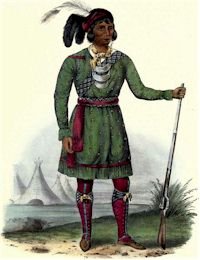The close of the troubles with the Florida Indians resulted in their removal to a reservation almost within the shadow of the Rocky Mountains. The tribe, the Seminoles, lost much of their prestige, and became discouraged upon the death of Osceola. The last battle of those terrible swamp skirmishes could be called by the legitimate term of regular pitched battles and occurred December 8th, 1842. The first conflict occurred on the 19th of July, 1835. This second war followed closely upon the treaty which was supposed to have removed beyond any possibility the chance of another outbreak. But only with his total extinction will the Indian forget a wrong either fancied or real. They still brooded over their fancied wrongs. For them, as is told of those who wanted opportunity, the opportunity was made. A settler, newly arrived, and who had located near one of the largest of the Seminole towns, lost two or three of his horses, and entertaining the idea that the Indians were naturally thieves, at once proceeded to the nearest military post and made complaint with such additions and exaggerations to his story as he thought necessary to insure a prompt reprisal and rescue of his property from the depredators. This fermented the ill-feeling of the Indians, who in reality had not taken the horses, for they were afterwards found in a swamp some miles away from their owner’s house, whither they had strayed. One night the settler’s house was fired by a band of about thirty Indians, his wife murdered, and he himself escaping by the merest chance from a similar fate. Thus began a conflict fiercer than any that had preceded it, and which lasted nearly twelve years. There were truces proclaimed, conferences ensued between appointed representatives of our Government and the warriors of the Seminoles, but they invariably resulted in failure.

Signifies the “Rising Sun”
A Seminole Leader
Osceola being dead, the Seminole Nation lost its ruler. Brave, a skillful fighter, always keenly observant of his advantages, and being almost idolized by his people, it cannot be wondered at that with his departure to the happy hunting grounds, his death song should also sound to his mourning tribe as the requiem of their own existence as a nation.
Their transposition from Florida to their Western Reservation relieved the Government of maintaining expensive military posts in the South, and gave fresh impetus to the settlements of that State. Among the warriors of the tribe Billy Bowlegs became somewhat famous. Although by no means possessing the genius and administrative abilities of Osceola, he nevertheless commanded the respect of his people in an eminent degree. Of his history but little is known, save that his father was a great warrior, who, in his prime, was killed in a foray upon the borders of Georgia and Alabama.
Billy Bowlegs was of a fierce, unrelenting disposition, and was lacking in that degree of humanity which, with all his rage against the whites, marked the character of Osceola. Compared with Black Hawk and Phillip of Massasoit, however, neither of these notable warriors of the Seminole tribe were equal in point of ability or greatness of soul.
Bowlegs visited Washington soon after peace was declared, and was received by the President and other officials with great kindness. His reception and the exhibition to him of our power as a nation, both in the acts of peace and of war, produced a marked change in his mind. He had not before fully comprehended the extent of our population, nor had he placed any confidence in the reports brought to him in his native fastnesses of the military strength of the foe he had so persistently attempted to drive from his sight. He learned by what he saw how futile would be the further efforts of the remnant of his tribe, once the most powerful and warlike in the South, to cope with the standard bearers of civilization, and in taking his farewell of the President, he so expressed himself. After a brief visit to New York and other cities of the seaboard, he returned to his warriors, and joined them in their sorrowful march toward the setting sun.
It is somewhat significant, if the assumption of a celebrated historical writer be true, that the continent was first inhabited by Nomadic tribes from the Eastern Hemisphere, that, as then as they increased in numbers they traveled eastward toward sunrise, now, in their decline, they should be slowly driven to the westward toward sun set, thus closing their day of existence in darkness.
There are now left in Florida, however, a few, not over one hundred, of the Seminoles, who are descendants of those who once ruled the territory. These have embraced a civilized life, and in the main one exceedingly peaceful and industrious, most of them being engaged in agricultural pursuits. The women employing their time in the manufacture of bead goods, ornamental and useful, quantities of which are sent northward.
